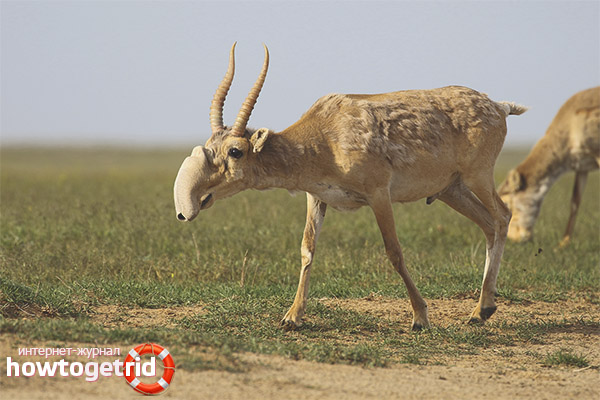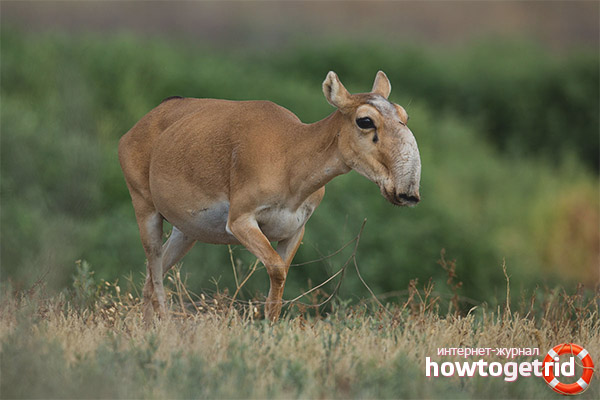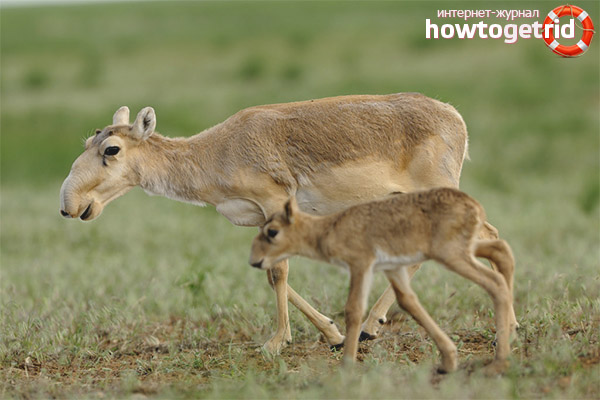The content of the article
By saiga is meant a wild animal classified as artiodactyl mammal. Individuals prefer living in the expanses of our homeland, respectively, their distribution affects the steppes of the Russian Federation. Animals have been known to people since ancient times, but now their way of being has been studied in more detail. It is believed that this artiodactyl belonged to mammoths and saber-toothed tigers. However, this theory has a thousand contradictions. Today we will consider everything that affects saigas, so that you make up your mind.
Habitat
- Previously, these representatives of the family were distributed throughout Eurasia. However, then the population declined sharply due to the ice age. Animals moved to the steppes and began to settle there.
- These animals always prefer living in open areas. They need flat soil, rocky or clay. It is also important that the soil does not fall through and is stable. Animals pick up a territory that does not have elongated forest strips. Individuals protect themselves from potential enemies and lead a fairly hidden way of being.
- To date, most of the livestock are scattered across Kazakhstan, Turkmenistan, Russia, Uzbekistan, Kalmykia and Mongolia. It is in these states that the natural environment is most suitable for wild antelopes. They are very shy by nature, do not come close to human dwelling. Animals feed on cereals, grass. Virtually no need for water.
Description
- By saiga is meant a medium-sized cloven-hoofed individual, which is a mammal. It has certain features that allow you to distinguish the animal from the rest. On the body in length grows to 1.3 m. With a mass of 80 cm. A distinctive feature is the trunk.
- By pigmentation, individuals are not distinguished. They are painted light gray or reddish with brownish splashes. Pigmentation depends on the season in question. The mass of the case varies between 20–35 kg., But there are more severe representatives of the family. Their weight reaches 60 kg. and more.
- Another distinctive feature is hooves. Animals leave traces in the form of a heart in the soil. Hooves are forked. They may be similar to the prints of domestic sheep. These antelopes practically do not make sounds, but can scream, calling for help or notifying oneself-like about the danger.
- The movements of individuals are calm, balanced. They walk with their heads bowed. However, when the danger makes itself felt, family members can reach speeds of up to seventy kilometers per hour. With such indicators, individuals can move for 10 kilometers or more. During the run, you can observe vigorous jumps.
- As for gender differences, there are practically none. However, some features, including horns, are still present. In individuals of male gender, they grow from the moment of birth. Closer to six months they turn black and then become highlighted. In structure, they are waxy, translucent. They are bent in format, and in terms of overall characteristics they can reach 40 cm.
- Partly because of the quality of the horns and their pricing policy, poaching has been developing recently. On the black market, they can be sold for a tidy sum, so people destroy antelopes without a drop of regret. Animals try to hide from a person with all possible forces, because people are considered their worst enemies.
Lifestyle
- Discussed family members like to live in a herd.They collect on average 30 individuals, but much larger accumulations are found in the natural distribution environment, from 50 to 100 animals. By the nature of their stay, they are nomads, changing their habitats in search of better conditions.
- In the winter, they leave in the desert, because there is little snow. In the summer season they return to their native steppes. These individuals are distinguished by their endurance, they can survive even the most severe weather conditions. They adapt to the weather, human activities, and predator habitation. Cleverly hide.
- The saiga is able to live in conditions of severe cold or in unbearable heat for other individuals. When there is no water, individuals seek vegetation that can quench their thirst and need for valuable substances. The most powerful and hardy representatives of the herd successfully move from place to place, the weak, young and sick die.
- The herd has a leader who leads followers along unfamiliar paths. The head tries to cover a huge distance per day, thereby checking the rest of the wards for endurance. In the winter, they usually reach the designated area and fall into a rut. There are several leaders who fight among themselves for the fairer sex.
- They cause significant damage to each other. A weak member of the pack either surrenders or dies. In males, the lifespan is four years. Females live a little longer, about 8 years. Partly due to constant skirmishes, individuals of male identity die earlier. Wild antelopes are prolific. Starting from 7 months, females run into the race and are ready to bear babies. Already in the year the first offspring is born.
- Individuals of male affinity mature later, this period takes a couple of years. Females give birth at the end of spring. They retire and give birth so that other members of the herd do not interfere. Also, the mother tries to protect the cubs from people who want profit. For the first time, the baby is alone. In the rest several times there can be two, three.
- At first, the younger generation is helpless, therefore the mother everywhere defends the offspring. They lie motionless, then grow stronger and repeat everything after their parents. After a couple of weeks, the offspring is already moving in the pack, where adults protect the young. They can eat on their own only after a month.
Enemies
- The considered individuals prefer to lead mainly a daily life. Therefore, at night they are most vulnerable. The main enemy in the natural nature of such animals is the steppe wolf. The predator is not very strong, but he is very smart.
- The only way out for salvation is flight. Only in this way can a saiga escape death. In fact, wolves do a huge favor to the individuals in question. The bottom line is that predators select exclusively weakened individuals from the entire herd. Therefore, the victims are slow individuals.
- In some cases, when wild predators awaken a brutal appetite, they can destroy a quarter of the entire herd. In addition, saigas are subject to no small danger from foxes, stray dogs and jackals. Often such young animals and very small cubs of antelopes suffer from such predators.
- It is worth noting that around the middle of the last century, hunting for the individuals in question was officially allowed. However, it lasted only 20 years. And already in the seventies, saigas again began to be protected. The problem is that by this time in the whole world there were no more than 35 thousand individuals. And in most cases they were just females.
- In the modern world, many specialists conduct special programs to restore the presented species throughout the world. People began to create reserves and protected areas only so that wild antelopes could quietly breed and exist. The most popular is the Rostovsky Nature Reserve. It is located on Manych Lake.
- Specialists of the wildlife fund have taken the protected species under protection. People have learned to control the population of such antelopes. Currently, saigas are listed in the Red Book. The number of individuals is gradually increasing. Specialists, in turn, receive various grants for their successful work. Due to this, animals are protected and guarded.
Breeding
- As for the breeding season, the breeding season falls mainly at the beginning of winter. It is noteworthy that males during the rut strive to create their own harems. Interestingly, females reach puberty much earlier than males.
- Female individuals are ready to give offspring already in the second year of life. It is curious that in individuals during the mating season, glands that are located near the eyes release fluid with a pungent and unpleasant odor. It has a brownish tint. Due to this feature, males can feel each other even at night.
- During the mating season between males, clashes constantly occur. Moreover, such fights are quite fierce. Individuals pounce on each other, clashing hard against the horns. The fight continues until one of the crippled males falls. Often, saigas die from such wounds. The winner goes to the females.
- The duration of the mating season lasts about 10 days. A strong and healthy male can have up to 50 females in the harem. And in the spring, each of them already has offspring. There can be from 1 to 3 cubs at a time. Before giving birth, the female leaves grief and leaves in the steppe.
Saigas are an endangered species. Currently, people are breeding them in reserves. Wild antelopes are protected. They are practically not in danger. In the protected area there are almost no natural predators.
Video: saiga (Saiga tatarica)













Submit